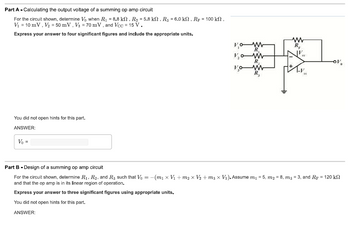
Introductory Circuit Analysis (13th Edition)
13th Edition
ISBN: 9780133923605
Author: Robert L. Boylestad
Publisher: PEARSON
expand_more
expand_more
format_list_bulleted
Concept explainers
Question
thumb_up100%

Transcribed Image Text:Part A - Calculating the output voltage of a summing op amp circuit
For the circuit shown, determine Vo when R₁ = 8.8 kn, R₂ = 5.8 kN, R3 = 6.0 kn, Rp = 100 kn,
V₁ = 10 mV, V₂ = 50 mV, V3 = 70 mV, and Vcc = 15 V.
Express your answer to four significant figures and include the appropriate units.
You did not open hints for this part.
ANSWER:
Vo =
V₂0 W
www
R₂
Ve
-OV
Part B - Design of a
hing amp circuit
For the circuit shown, determine R₁, R2, and R3 such that V₁ = -(m₁ x V₁ + m₂ × V₂ + m3 x V3). Assume m₁ = 5, m₂ = 8, m3 = 3, and R = 120 k
and that the op amp is in its linear region of operation.
Express your answer to three significant figures using appropriate units.
You did not open hints for this part.
ANSWER:

Transcribed Image Text:V₁
V₂0-W
R₂
v₂ow
R₁
You did not open hints for this part.
ANSWER:
R1 =
minimum V₁, maximum V₁ =
R2 =
R3 =
V
V
Part C Saturation of a summing op amp circuit
For the circuit shown, determine the range (i.e., maximum and minimum values) of V₁ such that the op
amp operates in the linear region. Assume that R₁ = 2.0 kn, R₂ = 8.2 kn, R3 = 2.2 kn, RF = 200
k. V₂ = 60 mV, V3 = 140 mV, and Vcc = 15 V.
Express your answer to three significant figures separated by a comma.
mV, mV
V |-
ww
R₁
V₂
v|-|
WW
R₂
WWW
-OV
www
-OV
Expert Solution
This question has been solved!
Explore an expertly crafted, step-by-step solution for a thorough understanding of key concepts.
Step by stepSolved in 4 steps with 3 images

Knowledge Booster
Learn more about
Need a deep-dive on the concept behind this application? Look no further. Learn more about this topic, electrical-engineering and related others by exploring similar questions and additional content below.Similar questions
- 25. Consider the circuit diagram depicted in the figure. R₂ 2.5- E1-18 V R₁ a M 0.5 Ω E₂ = 45 V 0.50 R₁₂ 1.50 (a) If the current through the top branch is 12 = 0.02 A, what is the current through the bottom, /3, in amps? [Ans: 13=13.53 A]arrow_forwardThank you in advance for your answer.arrow_forwardAssume that the ideal op amp in the circuit in the figure is operating in its linear region, Take that R₁ = 45 k and R₂ = 18 kn. Part A Calculate the power delivered to the R₂. Express your answer with the appropriate units. ANSWER: PR₂ Express your answer with the appropriate units. ANSWER: PR₂ Part C Find the ratio of the power found in Part A to that found in Part B. ANSWER: 320mV Part B Calculate the power delivered to the R₂ with the op amp removed from the circuit, that is, with the R₂ resistor connected in the series with the voltage source and the R₁ resistor. PA/PB = + Source: Loadarrow_forward
- 10) i need fast please nowarrow_forwardVa=3V and Vb=0V so I think that this would result in an inverting op-amp and has the equation -(160/20)*3=-24V but this is wrong I tried the long way as well but got the same answer. The possible source of error could be the 5k resistor but that doesn't make to much sense to me. How do I solve this?arrow_forward1. Consider the ideal op-amp circuit below. Let Us = 0.1 V, R1 = R2 = R3 = R3 = 100 kN, and R4 = 98 kN, Solve for Vo. R1 RA R5 vo R2 Us R3arrow_forward
arrow_back_ios
arrow_forward_ios
Recommended textbooks for you
 Introductory Circuit Analysis (13th Edition)Electrical EngineeringISBN:9780133923605Author:Robert L. BoylestadPublisher:PEARSON
Introductory Circuit Analysis (13th Edition)Electrical EngineeringISBN:9780133923605Author:Robert L. BoylestadPublisher:PEARSON Delmar's Standard Textbook Of ElectricityElectrical EngineeringISBN:9781337900348Author:Stephen L. HermanPublisher:Cengage Learning
Delmar's Standard Textbook Of ElectricityElectrical EngineeringISBN:9781337900348Author:Stephen L. HermanPublisher:Cengage Learning Programmable Logic ControllersElectrical EngineeringISBN:9780073373843Author:Frank D. PetruzellaPublisher:McGraw-Hill Education
Programmable Logic ControllersElectrical EngineeringISBN:9780073373843Author:Frank D. PetruzellaPublisher:McGraw-Hill Education Fundamentals of Electric CircuitsElectrical EngineeringISBN:9780078028229Author:Charles K Alexander, Matthew SadikuPublisher:McGraw-Hill Education
Fundamentals of Electric CircuitsElectrical EngineeringISBN:9780078028229Author:Charles K Alexander, Matthew SadikuPublisher:McGraw-Hill Education Electric Circuits. (11th Edition)Electrical EngineeringISBN:9780134746968Author:James W. Nilsson, Susan RiedelPublisher:PEARSON
Electric Circuits. (11th Edition)Electrical EngineeringISBN:9780134746968Author:James W. Nilsson, Susan RiedelPublisher:PEARSON Engineering ElectromagneticsElectrical EngineeringISBN:9780078028151Author:Hayt, William H. (william Hart), Jr, BUCK, John A.Publisher:Mcgraw-hill Education,
Engineering ElectromagneticsElectrical EngineeringISBN:9780078028151Author:Hayt, William H. (william Hart), Jr, BUCK, John A.Publisher:Mcgraw-hill Education,

Introductory Circuit Analysis (13th Edition)
Electrical Engineering
ISBN:9780133923605
Author:Robert L. Boylestad
Publisher:PEARSON

Delmar's Standard Textbook Of Electricity
Electrical Engineering
ISBN:9781337900348
Author:Stephen L. Herman
Publisher:Cengage Learning

Programmable Logic Controllers
Electrical Engineering
ISBN:9780073373843
Author:Frank D. Petruzella
Publisher:McGraw-Hill Education

Fundamentals of Electric Circuits
Electrical Engineering
ISBN:9780078028229
Author:Charles K Alexander, Matthew Sadiku
Publisher:McGraw-Hill Education

Electric Circuits. (11th Edition)
Electrical Engineering
ISBN:9780134746968
Author:James W. Nilsson, Susan Riedel
Publisher:PEARSON

Engineering Electromagnetics
Electrical Engineering
ISBN:9780078028151
Author:Hayt, William H. (william Hart), Jr, BUCK, John A.
Publisher:Mcgraw-hill Education,